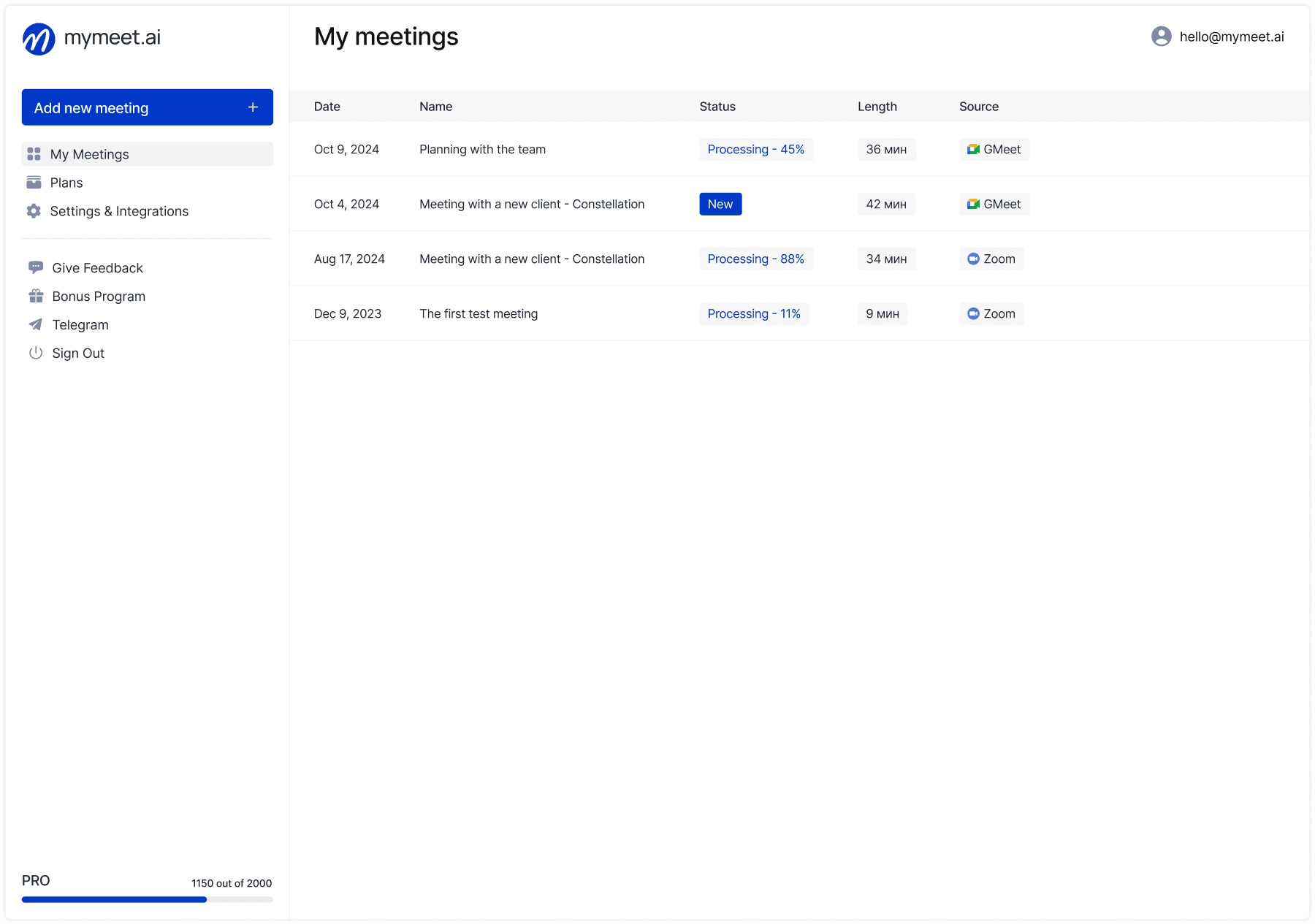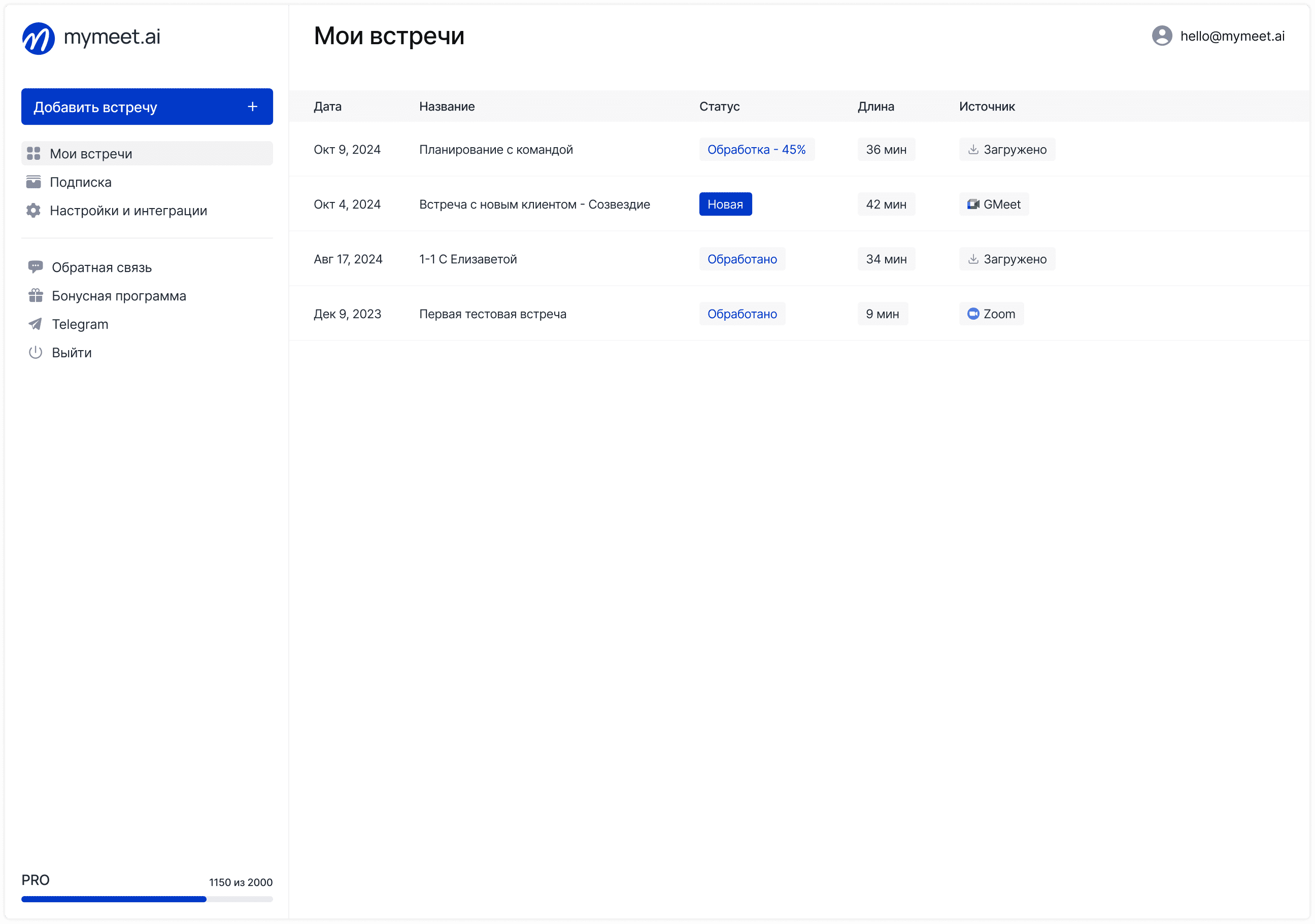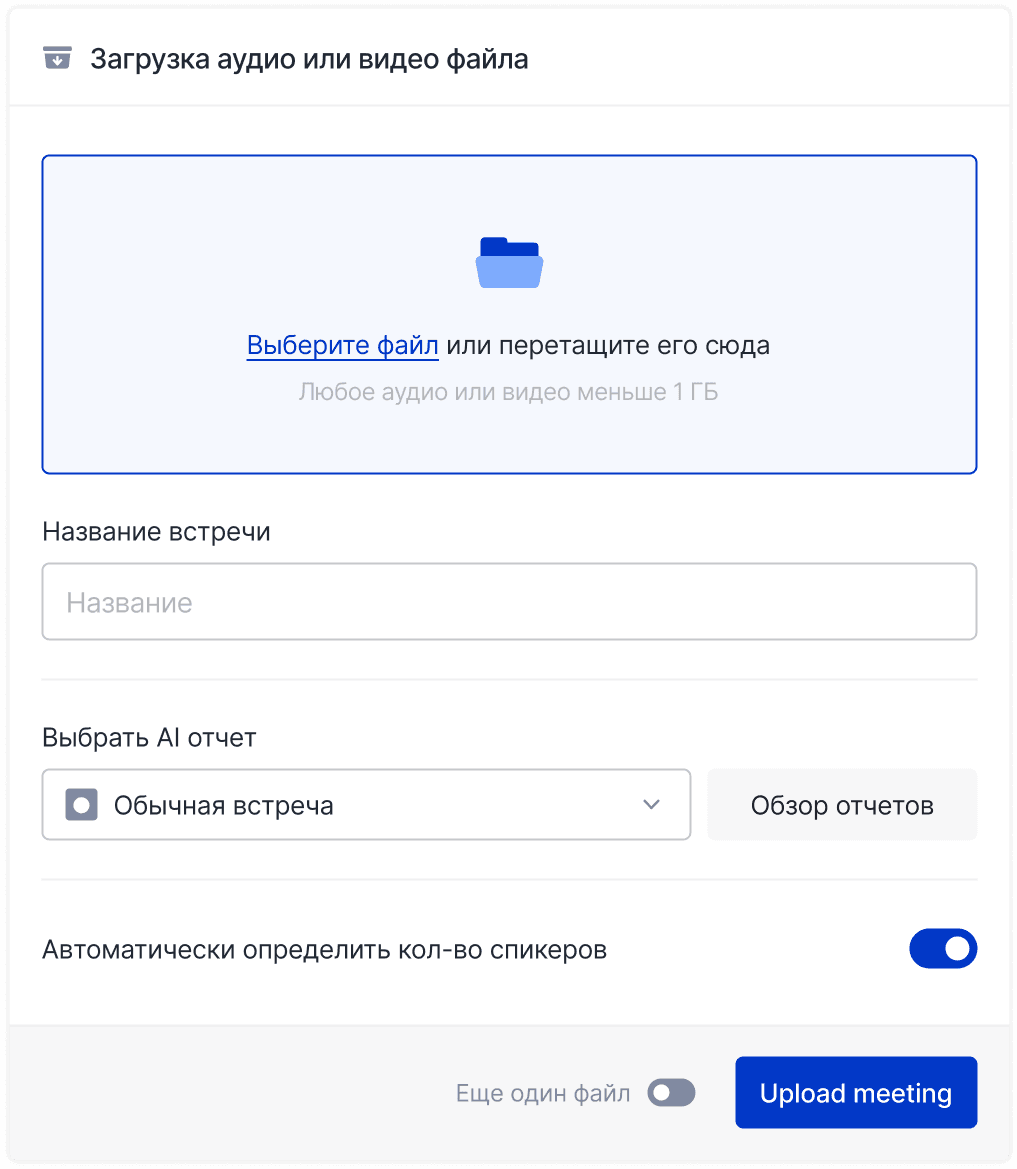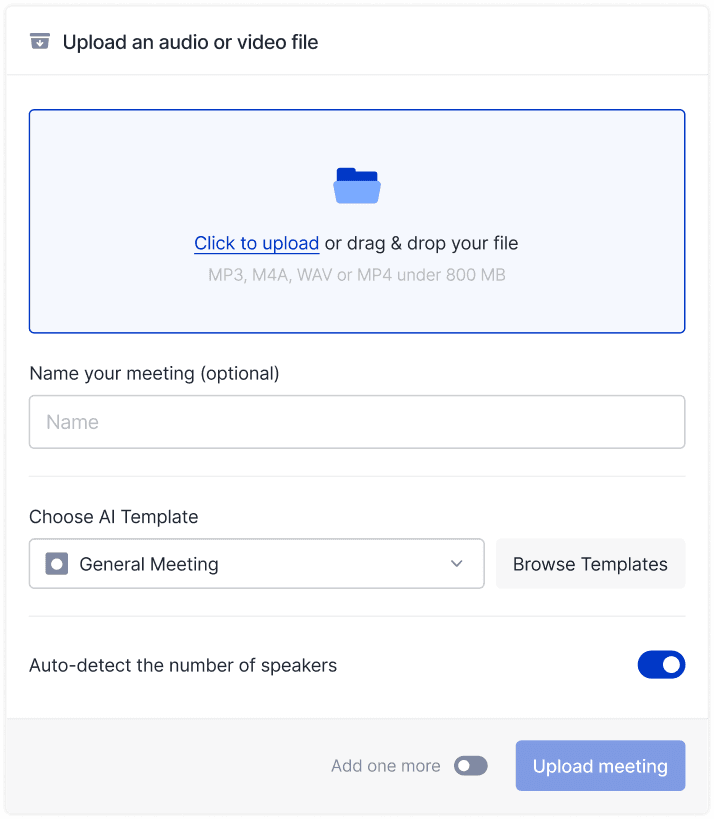Technology & AI

Ilya Berdysh
Sep 17, 2025
Google Meet is used by 85% of Google Workspace teams, while Zoom is chosen by 70% of companies for important presentations, yet only 25% of organizations consciously compared these platforms before making their choice. Most simply use what's "available in the company" or "recommended by colleagues," even though the right choice can save up to ₽150,000 ($1,875) per year for a 20-person team.
Hello! The mymeet.ai team compared Google Meet and Zoom under real-world usage conditions — from quick calls to corporate presentations. We'll show you the honest advantages and disadvantages of each platform so you can choose a solution that truly fits your needs and budget.
Google Meet vs Zoom: Key Differences
Google Meet and Zoom represent two different philosophies of video conferencing — maximum simplicity versus rich functionality.
What's the Main Difference Between Meet and Zoom
Understanding the basic principles of each platform will help you quickly determine which better matches your needs.
Google Meet — simplicity above all.

The platform is created for maximally fast and simple video calls. Works in browser, minimal settings, one-click connection. Ideal for situations where "you need to connect urgently."
Zoom — master of functionality.

The platform is designed for professional meetings with rich interaction capabilities. Breakout rooms, interactive whiteboards, detailed settings. Created for situations where "you need to conduct an effective work meeting."
What Tasks Meet and Zoom Were Created For
Each platform is optimized for different usage scenarios and user types.
Google Meet is oriented toward: quick meetings, international Google Workspace teams, simple presentations, users without technical training.
Zoom is oriented toward: regular work meetings, training and webinars, complex presentations, teams with high video conferencing functionality requirements.
Meet vs Zoom: Feature Comparison
A detailed feature comparison will show which aspects each platform excels in over its competitor.
Video Quality: Meet vs Zoom
Video connection quality is a fundamental criterion for choosing a video conferencing platform.
Google Meet: Stable HD quality with good internet. Automatic subtitles in 10+ languages. Works well in the browser but may experience issues with weak connections. Simple switching between views.
Zoom: Industry-leading video quality with adaptation to any internet connection. Supports up to 1080p for all participants. Advanced AI noise suppression. Works excellently even with unstable connections.
Winner: Zoom — excels in video connection quality and stability.
Ease of Use: Meet or Zoom
How quickly a new user can start working effectively with the platform.
Google Meet: Maximum simplicity — works directly in Gmail browser or Google Calendar. One-click meeting connection. Minimum buttons and settings. Suitable even for elderly users.
Zoom: Simple but requires application installation for full functionality. More buttons and options. Takes 5-10 minutes to figure out the interface. External participants connect easily.
Winner: Google Meet — maximum ease of use.
Meeting Features: Google Meet vs Zoom
Comparison of specific capabilities for conducting effective work meetings.
Google Meet: Screen sharing, meeting recording (paid), chat, automatic subtitles, Google Calendar integration. Basic capabilities without excess.
Zoom: Breakout Rooms, interactive whiteboard, polls and quizzes, reactions, screen annotations, waiting room, detailed security settings.
Winner: Zoom — significantly more capabilities for interactive meetings.
Collaboration in Meet and Zoom
Capabilities for team collaboration during and after meetings.
Google Meet: Integration with Google Workspace — collaborative editing of documents, presentations, spreadsheets directly during meetings. Shared Google Drives, document comments.
Zoom: Basic chat, file sharing, interactive whiteboard. Focus on meeting quality itself rather than document collaboration. Rich ecosystem of integrations.
Winner: Google Meet — better for document collaboration.
Google Meet vs Zoom Pricing: What's Cheaper
Usage cost often becomes the deciding factor when choosing a video conferencing platform.
How Much Meet and Zoom Cost
Different pricing models affect final expenses for different usage types.
Google Meet:
Free: meetings up to 60 minutes, up to 100 participants
Google Workspace Business Starter: $6/month (≈₽480)
Google Workspace Business Standard: $12/month (≈₽960)
Google Workspace Business Plus: $18/month (≈₽1,440)
Zoom:
Basic: free (40 minutes for group meetings)
Pro: $14.99/month (≈₽1,200)
Business: $19.99/month (≈₽1,600)
Enterprise: from $19.99/month (≈₽1,600)
Real Savings: Meet vs Zoom
Calculation for a 15-person team per year shows substantial cost difference.
Google Meet (Workspace Business Starter): $6 × 15 × 12 = $1,080 (≈₽86,400) + full office suite Zoom Pro: $14.99 × 15 × 12 = $2,698 (≈₽215,800) video conferencing only
Savings with Google Meet: $1,618 per year (≈₽129,400) + Gmail, Drive, Docs, Sheets
Verdict: Google Meet is significantly cheaper, especially if you need office applications.
Google Meet vs Zoom: Detailed Comparison Table
An objective comparison of key characteristics will help make an informed decision. Each criterion was evaluated under real-world usage conditions.
Criterion | Google Meet | Zoom | Winner |
Video Quality | Good with stable internet | Excellent, adapts to connection | 🏆 Zoom |
Ease of Use | Maximum, works in browser | Simple, but needs application | 🏆 Meet |
Meeting Features | Basic capabilities | Breakout rooms, whiteboard, polls | 🏆 Zoom |
Cost | $6/month + office suite | $14.99/month video only | 🏆 Meet |
External Participants | Browser connection | Simple link connection | Tie |
Integrations | Deep with Google services | 2000+ applications | 🏆 Zoom |
Automatic Subtitles | 10+ languages including Russian | English only | 🏆 Meet |
Mobile Devices | Good applications | Excellent applications | 🏆 Zoom |
Collaboration | Google Docs in real time | Basic, through integrations | 🏆 Meet |
International Teams | Works everywhere stably | Excellent for any countries | Tie |
Overall Score: Google Meet — 4 wins, Zoom — 4 wins, 2 ties
Meet wins in simplicity and cost. Zoom excels in functionality and video connection quality.
Meet vs Zoom Integrations
The ability to connect to work tools is critically important for productive use.
Google Meet Integrations with Other Services
Meet is created as part of the Google ecosystem and works best with this company's products.
Built-in integrations: Gmail, Google Calendar, Google Drive, Google Docs, Sheets, Slides, Google Classroom, Google Sites.
External integrations: Slack, Trello, Asana, popular CRMs via API. The number of integrations is limited compared to Zoom.
Advantages: Seamless work with Google services used by most teams. Automatic invitations, shared documents.
Zoom Integrations: Quantity and Diversity
Zoom offers one of the richest integration ecosystems among video conferencing platforms.
Popular integrations: Salesforce, Microsoft Teams, Slack, HubSpot, Trello, Asana, Calendly, Zapier, thousands of CRM and business applications.
Ecosystem: Zoom App Marketplace with more than 2,000 applications and integrations. Active developer community.
Advantages: Connects to any work tools, flexible settings, API for custom integrations.
Winner: Zoom for diversity, Meet for depth of Google integration.
Meet vs Zoom Security: What's More Reliable
Corporate security is becoming an increasingly important criterion for platform selection.
Google Meet Security
Meet uses Google's corporate security infrastructure with time-tested solutions.
Protection features: Encryption in transit, access control through Google accounts, protection from unauthorized entry, GDPR compliance, HIPAA (in corporate plans).
Management: Centralized management through Google Admin Console, organization-level policies, detailed activity logs.
Zoom Security: Improvements After 2020
After security issues in 2020, Zoom significantly strengthened data protection.
Protection features: End-to-end encryption for confidential meetings, waiting rooms, meeting passwords, recording control, SOC 2 compliance, HIPAA.
Management: Detailed administrator settings, organization-level security policies, user action auditing.
Verdict: Both solutions offer high security levels, Meet has the advantage of a stable reputation.
Mymeet.ai for Meet and Zoom: Universal Analysis

Regardless of the choice between Google Meet and Zoom, most teams need analysis of meeting results. Mymeet.ai works with both platforms and transforms any meeting into structured information.

✅ Meet and Zoom support — automatic connection to meetings on any platform
✅ Comparative analytics — effectiveness metrics for different meeting types regardless of platform
✅ Automatic transcription — accurate speech-to-text conversion for meetings in Russian

✅ Smart reports — extraction of key decisions, tasks, and agreements
✅ Unified search — ability to find any discussion from meetings on different platforms

✅ Work tool integration — synchronization with CRM, project systems, calendars
Case Study: Agency Choosing Between Meet and Zoom
A digital agency from Yekaterinburg (28 employees) was choosing between Google Meet and Zoom for client work. Meet won for internal meetings due to simplicity and Google Workspace integration. Zoom was kept for important client presentations due to better video quality and features.
Mymeet.ai implementation results:
Unified meeting analysis regardless of platform
Automatic client reports from Zoom presentation results
Internal planning meeting protocols from Google Meet with team tasks
Comparison of different meeting format effectiveness
8 hours per week saved on report compilation
ROI solution: proper use of each platform for specific tasks + automation of analysis
Maximize meeting effectiveness on any platform. Contact a consultant through the form to set up automatic Meet and Zoom analysis.

When to Choose Google Meet
Google Meet will be the optimal choice for certain types of teams and usage scenarios.
Meet Is Better Than Zoom for Which Tasks
Simple regular team meetings. Meet is ideal for daily standups, quick syncs, status calls. You can connect instantly from calendar or Gmail.
International teams with language barriers. Automatic subtitles in 10+ languages help participants better understand each other. Especially valuable for multicultural teams.
Limited budget with office application needs. Meet + Google Workspace costs less than Zoom + Microsoft Office. You get video conferencing + full office suite.
Teams without technical knowledge. Meet's maximum simplicity suits users who fear complex interfaces and settings.
Types of Companies for Choosing Meet
Startups and small business with limited budget
International distributed teams
Non-profit organizations and educational projects
Consultants and freelancers with simple needs
When to Choose Zoom
Zoom exceeds Google Meet in scenarios where functionality and video conferencing quality matter.
Zoom Is Better Than Meet for Which Organizations
Regular training meetings. Breakout rooms for group work, polls, interactive whiteboard, detailed recording — critically important for effective learning.
Client presentations and sales. Better video quality, professional appearance, reliable operation with any internet creates the right impression on clients.
Large teams with complex meetings. Up to 1,000 participants, detailed rights management, advanced security settings for corporate use.
Integration with diverse tools. 2,000+ integrations allow connecting Zoom to any CRM, project systems, marketing platforms.
Types of Business for Choosing Zoom
EdTech companies and online schools
Consulting agencies with client presentations
IT companies with technical training
Product teams with regular demos and retrospectives
Switching Between Meet and Zoom
Changing video conferencing platforms requires planning to maintain team productivity.
How to Switch from Zoom to Google Meet
Main challenges: Loss of advanced features (breakout rooms, polls), need for Google Workspace licenses, retraining users to simpler interface.
Migration plan: Getting Google Workspace subscription, migrating calendars and contacts, training team on Google Docs integrations, setting up new meeting processes.
Loss compensation: Using Google Jamboard instead of Zoom Whiteboard, Google Forms for polls, Google Meet Breakout Rooms (in paid plans).
How to Switch from Meet to Zoom
Main challenges: More complex interface, additional expenses, need to set up integrations with Google services.
Migration plan: Getting Zoom licenses, setting up integrations with Google Calendar and Gmail, training team on advanced features, reviewing meeting processes.
Additional opportunities: Implementing breakout rooms in training, using polls for engagement, setting up automatic recording of important meetings.
Conclusion: Meet vs Zoom — Choose for Your Tasks
Google Meet and Zoom are two quality solutions for different needs. Meet excels in ease of use, cost, and integration with Google services. Zoom leads in video connection quality, meeting functionality, and integration diversity.
The choice depends on your priorities: simplicity and savings versus functionality and quality. Many teams successfully use both platforms for different scenarios — Meet for quick internal meetings, Zoom for important presentations.
Ready to maximize meeting effectiveness regardless of chosen platform? Test mymeet.ai free — 180 minutes of automatic meeting analysis without card binding.
FAQ: Google Meet vs Zoom
What's better: Google Meet or Zoom?
Google Meet is better for Google Workspace teams, simple meetings, limited budget — $6/month includes office suite. Zoom is better for advanced meeting features, high video quality, training — breakout rooms, whiteboard, polls. Choice depends on priorities: simplicity vs functionality.
How much do Google Meet and Zoom cost?
Google Meet $6/month in Workspace (video + Gmail + Drive + Docs). Zoom $14.99/month video conferencing only. Meat is 2.5 times cheaper and includes a full office suite. For a 20-person team, Meet saves $2,160 per year.
Where is video quality better in Zoom or Meet?
Zoom excels in quality — better with weak internet, 1080p for everyone, advanced noise suppression. Google Meet is good with stable connections but may lag with poor internet. Zoom is chosen for important presentations, Meet is sufficient for regular meetings.
What's simpler to use: Meet or Zoom?
Google Meet is simpler — works in browser, one-click connection from Gmail, minimum buttons. Zoom requires application, more settings, but learned in 10 minutes. Meet for inexperienced users, Zoom for those needing capabilities.
What to choose for online learning: Zoom or Meet?
Zoom is better for education — breakout rooms for group work, polls for knowledge checks, interactive whiteboard, lesson recording. Meet suits simple lectures with Google Classroom. Most online schools choose Zoom for learning features.
What features does Zoom have that Meet doesn't?
Zoom excels — breakout rooms, interactive whiteboard, polls, reactions, annotations, waiting room. Google Meet has basic features: screen sharing, chat, auto-subtitles. Zoom for interactive meetings, Meet for simple calls.
Can Meet and Zoom be used for free?
Google Meet free 60 minutes for groups, Zoom 40 minutes. Meet works in the browser without registration, Zoom requires an account. For constant use, better paid versions — Meet $6/month, Zoom $15/month.
What's more secure: Google Meet or Zoom?
Both platforms are secure. Google Meet uses proven Google infrastructure, GDPR compliant. Zoom strengthened protection after 2020, added end-to-end encryption. Meet has a stable reputation, Zoom more corporate settings.
How to connect to meetings in Meet and Zoom?
Google Meet — click link, works in browser, can from Gmail/Calendar. Zoom — click link, may require app installation, works in browser with limitations. Meet simpler for quick connection.
What to choose for small business Meet or Zoom?
Google Meet is more profitable — $6/month includes video + office suite versus $15 for Zoom only. Meet covers 80% of small business needs. Zoom needed with requirements for advanced meeting features, training, presentations.
Ilya Berdysh
Sep 17, 2025








